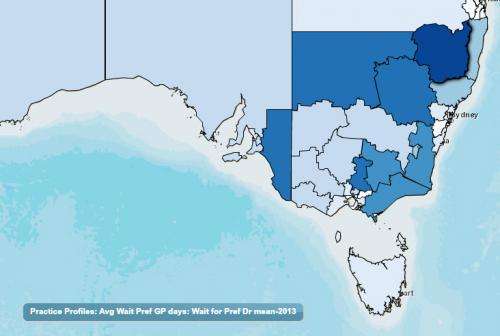Double trouble with rural waiting times for GPs

Waiting times to see preferred GPs in the bush are double those of Australia's city dwellers.
Analysis of new data from the Medicine in Australia, Balancing Employment and Life (MABEL) survey shows Australians living in rural areas waited an average of 6.0 days to see their preferred GP in 2013 compared to 3.1 days in metropolitan areas.
The Australian National University (ANU) National Centre for Geographic and Resource Analysis in Primary Health Care (GRAPHC) has made available interactive on-line maps for a range of data about GPs from the MABEL survey, which highlights issues such as regional differences in waiting times.
"Longer waiting times to see a GP are just one implication of the relative shortage of GPs in rural areas, and the MABEL data shown on the GRAPHC maps highlight many other differences like practice sizes and bulk billing rates," said Dr Ian McRae, health economist with the ANU Australian Primary Health Care Research Institute.
The issue is highlighted by data from New South Wales, where Northern Sydney patients were likely to see their GP within 1.5 days while patients in New England waited an average of 13.8 days, the worst performing region nationally.
Other states are seeing similar issues, including a difference of 9.7 days between the best and worst performing regions of Victoria, 7.3 days in Queensland and 6.4 days in South Australia.
Through HealthLandscape Australia, the interactive on-line mapping tool from GRAPHC at ANU, all Australians can now access six years of GP survey data providing insights into the diversity of primary health care in Australia.
This is the first time the data has been made freely available to the public.
Data includes wait time for preferred GP, wait time for any GP, patients per week, consultation time, GP demographics, percentage bulk billed and standard consultation fees.
Mapping tools help users visualise and compare health and demographic information, view trends over time, integrate their own data and share maps.
Using the new data, HealthLandscape Australia also reveals the increasing burden placed on rural GPs to provide after-hours services.
In 2013 rural GPs were more than twice as likely to work on call compared to their city counterparts – an average of 57 per cent compared to 24 per cent.
Since 2008, on-call participation has notably dropped, down 44.7 per cent in the metropolitan areas but only down 22.6 per cent in rural regions.
"Rural practice is both a rewarding and challenging experience for GPs," said Dr Mathew McGrail, lead researcher for Rural Workforce Supply and Distribution with MABEL, a survey of Australian doctors which has now been running for seven years and is conducted by the University of Melbourne and Monash University.
"Rural doctors generally work longer hours, are notably more likely to undertake on-call work, and have more difficulty getting time-off compared to urban GPs."
Paul Konings, spatial scientists with GRAPHC at the ANU, said the data was important for all Australians to better understand primary health care needs.
"Visualising the data on a map allows us to see where regional variation lies," Mr Konings said.
"Combining this with demographic or socio-economic information then enables us to understand which groups are most at risk and why. This is particularly important when it comes to Australia's healthcare."
Dr McGrail said the work of GRAPHC to map the GP workforce and MABEL to collect unique and up to date data on the workforce enables better health workforce planning for the future.
"MABEL continues to seek improved understanding of the decisions of doctors which contribute to their decisions on where to work and how to work," he said.
More information:
For more information on GRAPHC please visit graphc.aphcri.anu.edu.au
For more information on MABEL please visit mabel.org.au















